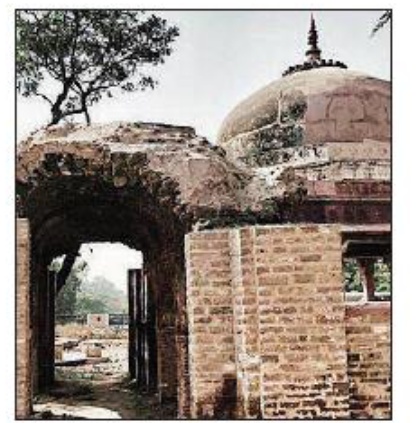Barnawa: lakshagriha/ Badruddin Shah shrine
This is a collection of articles archived for the excellence of their content. |
YEAR-WISE DEVELOPMENTS
2024: Feb
Feb 6, 2024: The Times of India
Court quashes Muslim side’s plea on occupation of ‘lakshagriha’ site
Ruling on a 53-year-old lawsuit filed by Muslim petitioners over what they claimed was encroachment on a 100-bigha piece of land, which the Hindu side believes housed the ‘lakshagriha’ (palace of lac) mentioned in the epic ‘Mahabhara ta’, the court of civil judge (junior division), Baghpat quashed the Muslim side’s plea, reports Sandeep Rai.
The site is situated on an ancient mound hill in Baghpat. It houses the tomb of Sufi saint Badruddin Shah as well as a graveyard.
Details
Sandeep Rai, February 6, 2024: The Times of India

From: Sandeep Rai, February 6, 2024: The Times of India
Meerut : Ruling on a 53-yearold lawsuit filed by Muslim petitioners over what they claimed was encroachment on a 100-bigha piece of land that Hindus believed housed the ‘lakshagriha’ (palace of lac) mentioned in the epic ‘Mahabharata’, the court of civil judge (junior division), Baghpat, in an order, quashed the Muslim side’s claims.
Situated on an ancient mound adjacent to the confluence of Hindon and Krishni rivers in Barnawa village of Baghpat district, there had been long-standing dispute over the site which houses a tomb of Sufi saint Badruddin Shah as well as a graveyard. It is currently a protected site under Archaeological Survey of India.
In 1970, the then mutwalli (caretaker) of the graveyard, Mukim Khan, filed a court petition, claiming ownership of the land bank with prayer to “restrain Hindus from encroaching upon the land, destroying graves and holding havan”. At that time a local priest, Krishnadutt Maharaj, was made a defendant in the case. The Hindu side claimed that the site housed the ‘lakshagriha’, a palace made of ‘lac’ that Duryodhana had built for Pandavas with the sinister plan of burning them to death.
Ranveer Singh Tomar, lawyer representing the Hindu side, said, “The 32-page court order has found glaring loopholes in the plaintiff’s claims on the property. For instance, the Muslim side claimed the Sufi saint’s tomb was 600 years old and after his death, a graveyard also came up, which was made waqf property by the ‘Shah’ of that time, but it could not provide the ruler’s name. In fact, there is no mention of the graveyard in govt records.”
The court also took cognisance of the Official Gazette dated Dec 12, 1920, which was produced by defendants, in which the ASI had stated: “A little mound to the south of the town called ‘Lakha Mandap’ is supposed to be the scene of attempt to burn the Pandavas, situated Barnawa, 19 miles NW from Meerut in Sardhana tehsil.”
The court observed that the Muslim side could not establish whether the disputed site was a waqf property or a graveyard in 1920.
Reacting to the court order, Shahid Ali, advocate on the plaintiff’s behalf, said, “It is true that we have lost the case but we will certainly go to the higher court.”
KK Sharma, associate professor, department of history, Multanimal PG College, Modinagar, who had been instrumental in the discovery of a Harappan-era burial site in Sinauli area of Baghpat in 2005, said, “All these structures are made on the top of an ancient mound. Within this mound is buried the history of different civilizations. In 2018, painted grey ware pottery was excavated during an ASI survey. The same pottery is found in Mathura, Meerut and Hastinapur and all of these cities find mention in Mahabharata…”